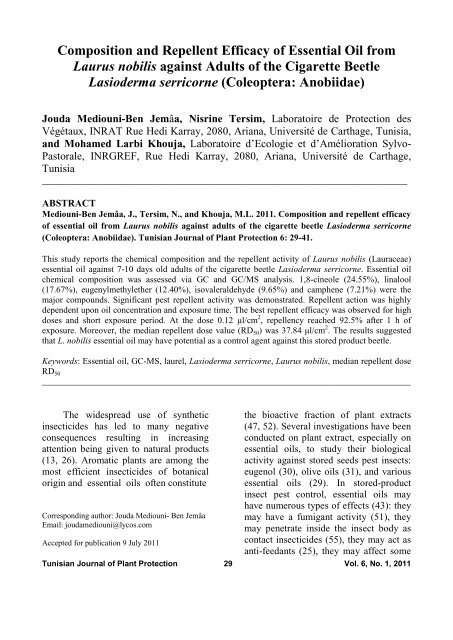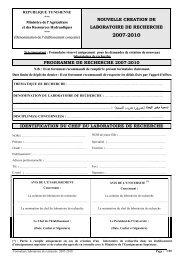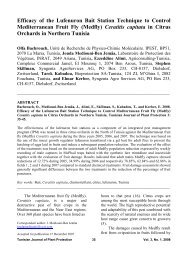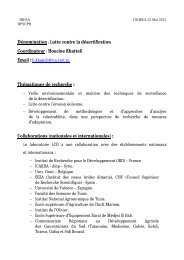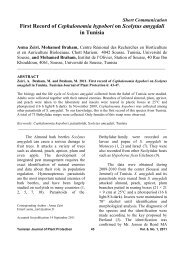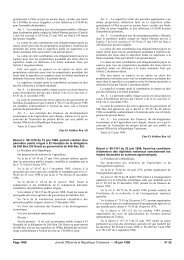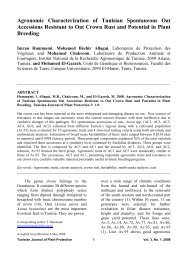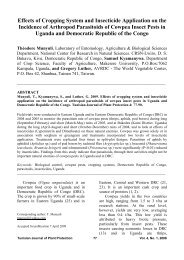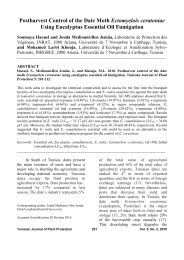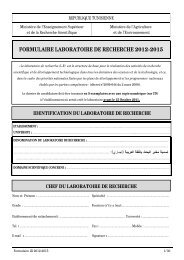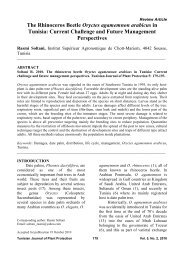Composition and Repellent Efficacy of Essential Oil from ... - Iresa
Composition and Repellent Efficacy of Essential Oil from ... - Iresa
Composition and Repellent Efficacy of Essential Oil from ... - Iresa
Create successful ePaper yourself
Turn your PDF publications into a flip-book with our unique Google optimized e-Paper software.
<strong>Composition</strong> <strong>and</strong> <strong>Repellent</strong> <strong>Efficacy</strong> <strong>of</strong> <strong>Essential</strong> <strong>Oil</strong> <strong>from</strong><br />
Laurus nobilis against Adults <strong>of</strong> the Cigarette Beetle<br />
Lasioderma serricorne (Coleoptera: Anobiidae)<br />
Jouda Mediouni-Ben Jemâa, Nisrine Tersim, Laboratoire de Protection des<br />
Végétaux, INRAT Rue Hedi Karray, 2080, Ariana, Université de Carthage, Tunisia,<br />
<strong>and</strong> Mohamed Larbi Khouja, Laboratoire d’Ecologie et d’Amélioration Sylvo-<br />
Pastorale, INRGREF, Rue Hedi Karray, 2080, Ariana, Université de Carthage,<br />
Tunisia<br />
__________________________________________________________________________<br />
ABSTRACT<br />
Mediouni-Ben Jemâa, J., Tersim, N., <strong>and</strong> Khouja, M.L. 2011. <strong>Composition</strong> <strong>and</strong> repellent efficacy<br />
<strong>of</strong> essential oil <strong>from</strong> Laurus nobilis against adults <strong>of</strong> the cigarette beetle Lasioderma serricorne<br />
(Coleoptera: Anobiidae). Tunisian Journal <strong>of</strong> Plant Protection 6: 29-41.<br />
This study reports the chemical composition <strong>and</strong> the repellent activity <strong>of</strong> Laurus nobilis (Lauraceae)<br />
essential oil against 7-10 days old adults <strong>of</strong> the cigarette beetle Lasioderma serricorne. <strong>Essential</strong> oil<br />
chemical composition was assessed via GC <strong>and</strong> GC/MS analysis. 1,8-cineole (24.55%), linalool<br />
(17.67%), eugenylmethylether (12.40%), isovaleraldehyde (9.65%) <strong>and</strong> camphene (7.21%) were the<br />
major compounds. Significant pest repellent activity was demonstrated. <strong>Repellent</strong> action was highly<br />
dependent upon oil concentration <strong>and</strong> exposure time. The best repellent efficacy was observed for high<br />
doses <strong>and</strong> short exposure period. At the dose 0.12 µl/cm 2 , repellency reached 92.5% after 1 h <strong>of</strong><br />
exposure. Moreover, the median repellent dose value (RD 50) was 37.84 µl/cm 2 . The results suggested<br />
that L. nobilis essential oil may have potential as a control agent against this stored product beetle.<br />
Keywords: <strong>Essential</strong> oil, GC-MS, laurel, Lasioderma serricorne, Laurus nobilis, median repellent dose<br />
RD 50<br />
___________________________________________________________________________________<br />
The widespread use <strong>of</strong> synthetic<br />
insecticides has led to many negative<br />
consequences resulting in increasing<br />
attention being given to natural products<br />
(13, 26). Aromatic plants are among the<br />
most efficient insecticides <strong>of</strong> botanical<br />
origin <strong>and</strong> essential oils <strong>of</strong>ten constitute<br />
Corresponding author: Jouda Mediouni- Ben Jemâa<br />
Email: joudamediouni@lycos.com<br />
Accepted for publication 9 July 2011<br />
the bioactive fraction <strong>of</strong> plant extracts<br />
(47, 52). Several investigations have been<br />
conducted on plant extract, especially on<br />
essential oils, to study their biological<br />
activity against stored seeds pest insects:<br />
eugenol (30), olive oils (31), <strong>and</strong> various<br />
essential oils (29). In stored-product<br />
insect pest control, essential oils may<br />
have numerous types <strong>of</strong> effects (43): they<br />
may have a fumigant activity (51), they<br />
may penetrate inside the insect body as<br />
contact insecticides (55), they may act as<br />
anti-feedants (25), they may affect some<br />
Tunisian Journal <strong>of</strong> Plant Protection 29 Vol. 6, No. 1, 2011
iological parameters such as growth rate,<br />
life span <strong>and</strong> reproduction (48, 44, 50) or<br />
they may act as repellents (41, 49).<br />
<strong>Repellent</strong>s are defined as substances that<br />
act locally or at a distance, deterring an<br />
arthropod <strong>from</strong> flying to, l<strong>and</strong>ing on or<br />
biting human or animal skin (or a surface<br />
in general) (8, 11). Usually, insect<br />
repellents work by providing a vapor<br />
barrier deterring the arthropod <strong>from</strong><br />
coming into contact with the surface (9).<br />
Among them, essential oils, complex<br />
mixtures <strong>of</strong> volatile compounds isolated<br />
<strong>from</strong> a large number <strong>of</strong> plants, have been<br />
found to have these properties against<br />
various haematophagous arthropods,<br />
some <strong>of</strong> them being the basis <strong>of</strong><br />
commercial repellent formulations (15).<br />
Mediterranean laurel Laurus nobilis<br />
(Lauraceae) is an evergreen shrub up to<br />
2.15 m height <strong>and</strong> commonly named bay<br />
laurel (2). It is native to the Southern<br />
Mediterranean region <strong>and</strong> widely<br />
cultivated in Europe <strong>and</strong> the USA as an<br />
ornamental plant (22). Bay leaf is widely<br />
used as a dried herb <strong>and</strong> gives a very<br />
fragrant <strong>and</strong> aromatic essential oil; it is<br />
used as a valuable spice <strong>and</strong> flavoring<br />
agent in the culinary <strong>and</strong> food industries<br />
<strong>and</strong> as an additive in cosmetics (12).<br />
Moreover, it is also widely used in folk<br />
medicine to treat gastrointestinal<br />
problems, rheumatism, diuretic, urinary<br />
problems <strong>and</strong> stones (1). In Tunisia, bay<br />
laurel is a common species called "R<strong>and</strong>".<br />
It grows at the edges <strong>of</strong> rivers, on<br />
mountains <strong>and</strong> on wet cliffs. It also grows<br />
in the humid <strong>and</strong> sub-humid bioclimatic<br />
areas, especially in Ain Draham, Tabarka,<br />
<strong>and</strong> Cap-Bon (46).<br />
The biological activities <strong>of</strong> L.<br />
nobilis have been extensively<br />
investigated. Kivçak <strong>and</strong> Mert (35)<br />
indicated that L. nobilis could be used as<br />
botanical biopesticide in postharvest crop<br />
protection. In this context, Papachristos<br />
<strong>and</strong> Stamopoulos (43) reported that L.<br />
nobilis essential oil has a repellent action,<br />
reduces fecundity, decreases egg<br />
hatchability, increases larval mortality<br />
<strong>and</strong> adversely influences <strong>of</strong>fspring to<br />
female <strong>of</strong> bean weevil Acanthoscelides<br />
obtectus. Correspondingly,<br />
Andronikashvili <strong>and</strong> Reichmuth (3), Saim<br />
<strong>and</strong> Meloan (49) indicated that L. nobilis<br />
essential oil had good repellency against<br />
the rust-red flour beetle Tribolium<br />
castaneum. In addition, Cosimi et al. (14)<br />
reported that L. nobilis essential oil had<br />
repellency against Sitophilus zeamais,<br />
Cryptolestes ferrugineus, <strong>and</strong> Tenebrio<br />
molitor.<br />
On the other h<strong>and</strong>, fumigant toxic<br />
<strong>and</strong> oviposition-deterring activities <strong>of</strong> L.<br />
nobilis essential oil were studied against<br />
the carmine spider mite, Tetranychus<br />
cinnabarinus (54). Similarly, Macchioni<br />
et al. (38) indicated that L. nobilis<br />
essential oil presented an acaricidal<br />
activity against Psoroptes cuniculi.<br />
Besides, the antifungal <strong>and</strong> antibacterial<br />
activities <strong>of</strong> L. nobilis oil were assayed.<br />
De Corato et al. (16) reported the<br />
antifungal activity <strong>of</strong> laurel oil against the<br />
three plant pathogenic fungi Botrytis<br />
cinerea, Monilinia laxa <strong>and</strong> Penicillium<br />
digitatum. Furthermore, the antibacterial<br />
activity <strong>of</strong> the various extracts has been<br />
assayed using the gram positive bacteria,<br />
Saphylococcus aureus ATTCC 25923 <strong>and</strong><br />
Enterococcus faecalis ATCC 29212, <strong>and</strong><br />
the gram negative bacteria, Escherichia<br />
coli ATCC 25922 <strong>and</strong> Pseudomonas<br />
aeruginosa ATCC 27853 (39).<br />
Additionally, Derwich et al. (17) showed<br />
that L. nobilis essential oil was very<br />
effective in vitro against three bacterial<br />
strains: S. aureus, S. intermedius <strong>and</strong><br />
Klebsiella pneumonia. Recently,<br />
Hassiotis (23) indicated that L. nobilis,<br />
Tunisian Journal <strong>of</strong> Plant Protection 30 Vol. 6, No. 1, 2011
abundant in the Mediterranean region,<br />
can influence the development <strong>of</strong> two<br />
mycorrhizal species, Glomus deserticola<br />
<strong>and</strong> G. intraradices.<br />
The cigarette beetle, Lasioderma<br />
serricorne is a cosmopolitan <strong>and</strong><br />
polyphagous stored product pest. L.<br />
serricorne is known to develop on a<br />
variety <strong>of</strong> grain-based products, spices,<br />
<strong>and</strong> tobacco, <strong>and</strong> infest these<br />
commodities during storage <strong>and</strong><br />
manufacturing (18). This beetle is among<br />
the main stored-product pests in Tunisia<br />
<strong>and</strong> North Africa (27).<br />
The cigarette beetle is one <strong>of</strong> the<br />
most ubiquitous <strong>of</strong> all stored-product<br />
insects. It occurs throughout the tropical<br />
<strong>and</strong> subtropical regions <strong>of</strong> the world. It<br />
occurs commonly in warm buildings<br />
throughout the temperate regions. It<br />
breeds on a wide variety <strong>of</strong> commodities,<br />
including both plant <strong>and</strong> animal materials<br />
(7, 24, 37), <strong>and</strong> is one <strong>of</strong> several beetle<br />
pests that commonly infest warehouses<br />
<strong>and</strong> retail stores (5).<br />
Effective management <strong>of</strong> the<br />
problem requires good sanitation,<br />
inspection <strong>of</strong> incoming goods, frequent<br />
rotation <strong>of</strong> stock, monitoring for the pest,<br />
removal <strong>of</strong> infested stock, <strong>and</strong> judicious<br />
application <strong>of</strong> biorational or conventional<br />
chemical insecticides. Historically,<br />
retailers <strong>and</strong> pest control operators have<br />
relied heavily on chemical pesticides (6).<br />
Nevertheless, the increasing awareness <strong>of</strong><br />
risk to environmental quality <strong>and</strong> human<br />
health has made necessary to seek safer<br />
methods. In this context, research over<br />
the last two or three decades has<br />
produced a variety <strong>of</strong> traps that are<br />
effective in detecting the pest (4, 34). The<br />
present work aims to investigate essential<br />
oil composition <strong>of</strong> L. nobilis <strong>and</strong> to<br />
evaluate its repellent efficacy against<br />
adults <strong>of</strong> L. serricorne.<br />
MATERIALS AND METHODS<br />
Insect rearing. The cigarette beetle<br />
L. serricorne was reared on wheat flour.<br />
A rearing colony was initiated in the<br />
Laboratory <strong>of</strong> Plant Protection<br />
(Entomology Section) at the Institut<br />
National de la Recherche Agronomique<br />
de Tunisie, Tunisia. The rearing<br />
conditions were darkness in 25 ± 1°C <strong>and</strong><br />
65% ± 5% relative humidity. Adult<br />
insects, 7-10 days old were used for<br />
repellency tests. This age was chosen<br />
because insects are more sensitive to oil<br />
treatment.<br />
Plant material. L. nobilis leaves<br />
were collected in February 2010 <strong>from</strong> the<br />
nursery <strong>of</strong> the experimental station <strong>of</strong><br />
Institut National de la Recherche en<br />
Génie Rural, Eau et Forêt at Ariana,<br />
Tunis, Tunisia. The harvested material<br />
was air-dried at room temperature (20-<br />
25°C) for one week <strong>and</strong> then stored in<br />
cloth bags.<br />
<strong>Essential</strong> oil extraction <strong>and</strong><br />
chemical analysis. <strong>Essential</strong> oil was<br />
extracted by hydrodistillation <strong>of</strong> dried<br />
leaves (100 g <strong>of</strong> each sample in 500 ml <strong>of</strong><br />
distilled water) using a modified<br />
Clevenger-type apparatus for 4 h. The<br />
oils were dried over anhydrous sodium<br />
sulphate <strong>and</strong> stored in sealed glass vials at<br />
4-5°C prior to analysis. Yield was<br />
averaged over four experiments <strong>and</strong><br />
calculated according to dry weight <strong>of</strong> the<br />
plant materials. Chemical analyses were<br />
performed at the Laboratory <strong>of</strong><br />
Bioprocesses, Centre de Biotechnologie<br />
de Sfax, Tunisia.<br />
The essential oils were analyzed<br />
using an Agilent-Technologies 6890 N<br />
Network GC system equipped with a<br />
flame ionization detector <strong>and</strong> HP-5MS<br />
capillary column (30 m × 0.25 mm, film<br />
thickness 0.25 µm; Agilent-Technologies,<br />
Little Falls, CA, USA). The injector <strong>and</strong><br />
Tunisian Journal <strong>of</strong> Plant Protection 31 Vol. 6, No. 1, 2011
detector temperatures were set at 220°C<br />
<strong>and</strong> 290°C, respectively. The column<br />
temperature was programmed <strong>from</strong> 80°C<br />
to 220°C at a rate <strong>of</strong> 4°C/min, with the<br />
lower <strong>and</strong> upper temperatures being held<br />
for 3 <strong>and</strong> 10 min, respectively. The flow<br />
rate <strong>of</strong> the carrier gas (Helium) was 1.0<br />
ml/min. A sample <strong>of</strong> 1.0 µl was injected,<br />
using split mode (split ratio, 1:100). All<br />
quantifications were carried out using a<br />
built-in data-h<strong>and</strong>ling program provided<br />
by the manufacturer <strong>of</strong> the gas<br />
chromatograph. The composition was<br />
reported as a relative percentage <strong>of</strong> the<br />
total peak area. The identification <strong>of</strong> the<br />
essential oils constituents was based on a<br />
comparison <strong>of</strong> their retention times to nalkanes,<br />
compared to published data <strong>and</strong><br />
spectra <strong>of</strong> authentic compounds.<br />
Compounds were further identified <strong>and</strong><br />
authenticated using their mass spectra<br />
compared to the Wiley version 7.0<br />
library. Major compounds (≥ 5%) <strong>and</strong><br />
other predominant components (0.5-5%)<br />
were marked in bold form.<br />
The retention time <strong>of</strong> a solute is<br />
taken as the elapsed time between the<br />
time <strong>of</strong> injection <strong>of</strong> a solute <strong>and</strong> the time<br />
<strong>of</strong> elution <strong>of</strong> the peak maximum <strong>of</strong> that<br />
solute. It is a unique characteristic <strong>of</strong> the<br />
solute <strong>and</strong> can be used for identification<br />
purposes while Kovats retention index<br />
(Kovats index or retention index) is a<br />
concept used in gas chromatography to<br />
convert retention times into systemindependent<br />
constants (36). The Kovats<br />
retention index <strong>of</strong> a certain chemical<br />
compound is its retention time<br />
normalized to the retention times <strong>of</strong><br />
adjacently eluting n-alkanes. While<br />
retention times vary with the individual<br />
chromatographic system (e.g. with<br />
regards to column length, film thickness,<br />
diameter, carrier gas velocity <strong>and</strong><br />
pressure, void time), the derived Kovats<br />
Tunisian Journal <strong>of</strong> Plant Protection 32<br />
retention indices are quite independent <strong>of</strong><br />
these parameters <strong>and</strong> allow comparing<br />
values measured by different analytical<br />
laboratories under varying conditions.<br />
Tables <strong>of</strong> Kovats retention indices can<br />
help identify components by comparing<br />
experimentally rimentally found Kovats retention<br />
indices with known values (36). The<br />
value <strong>of</strong> Kovats retention index is usually<br />
represented by I in mathematical<br />
expressions. Its applicability is restricted<br />
to organic compounds compounds. For isothermal<br />
chromatography, the Kovats retention<br />
index is given by the equation equation:<br />
where:<br />
I = Kovats retention index,<br />
n = the number <strong>of</strong> carbon atoms in<br />
the smaller alkane,<br />
N = the number <strong>of</strong> carbon atoms in<br />
the larger alkane,<br />
tr' ' = the adjusted retention time.<br />
For temperature programmed<br />
chromatography, the Kovats retention<br />
index is given by the equation equation:<br />
where:<br />
I = Kovats retention index,<br />
n = the number <strong>of</strong> carbon atoms in<br />
the smaller alkane,<br />
N = the number <strong>of</strong> carbon atoms in<br />
the larger alkane,<br />
z = the difference <strong>of</strong> the number <strong>of</strong><br />
carbon atoms in the smaller <strong>and</strong> larger<br />
alkane,<br />
tr = the retention time.<br />
Repellency bioassay bioassay.<br />
Filter paper tests tests. Repellency assays<br />
<strong>of</strong> L. nobilis essential oils were carried<br />
according to the experimental method<br />
described by Jilani <strong>and</strong> Saxena (28).<br />
Whatman filter papers (diameter 8 cm)<br />
Vol. 6, No. 1, 2011
were cut in half. Test solutions were<br />
prepared by dissolving 2, 4, 5 <strong>and</strong> 6 µl <strong>of</strong><br />
L. nobilis essential oil in 1 ml acetone.<br />
Doses were converted to give equivalent<br />
concentrations <strong>of</strong> respectively 0.04, 0.08,<br />
0.1 <strong>and</strong> 0.12 µl/cm 2 . Each solution was<br />
applied to half a filter-paper disc as<br />
uniformly as possible with a micropipette.<br />
The other half <strong>of</strong> the filter paper was<br />
treated with acetone alone as a control.<br />
The treated <strong>and</strong> control half discs were air<br />
dried under a fan to evaporate the solvent<br />
completely. Treated <strong>and</strong> untreated halves<br />
were attached to their opposites using<br />
adhesive tape <strong>and</strong> placed in Petri dishes.<br />
Twenty adult (7-10 days old) beetles <strong>of</strong><br />
mixed sex (ratio 1:1) were released at the<br />
centre <strong>of</strong> each filter paper disc. The<br />
dishes were then covered <strong>and</strong> sealed with<br />
Parafilm. Four replications were used for<br />
each concentration. Observations on the<br />
number <strong>of</strong> insects present on both the<br />
treated <strong>and</strong> untreated halves were<br />
recorded after 1, 3, 5 <strong>and</strong> 24 h for each<br />
tested concentration. Four trials were<br />
made for each concentration.<br />
Percentage repellency (PR) <strong>and</strong><br />
median repellent dose (RD50) <strong>of</strong> L.<br />
nobilis essential oil. Numbers <strong>of</strong> L.<br />
serricorne present on the treated <strong>and</strong><br />
untreated portions <strong>of</strong> the experimental<br />
paper halves were recorded after various<br />
periods <strong>of</strong> exposure. Percentage<br />
repellency (PR) was calculated according<br />
to Nerio et al. (42) as follows:<br />
PR = [(Nc – Nt)/(Nc + Nt)] × 100<br />
where Nc was the number <strong>of</strong> insects<br />
on the untreated area after the exposure<br />
interval <strong>and</strong> Nt was the number <strong>of</strong> insects<br />
on the treated area after the exposure<br />
interval. Four replications were used for<br />
each concentration. Probit analysis (20)<br />
was used to calculate the median repellent<br />
dose (RD50) (dose that repelled 50% <strong>of</strong><br />
the exposed insects) at 24 h <strong>of</strong> exposure.<br />
Results are presented as the mean <strong>of</strong><br />
percentage repellency ± the st<strong>and</strong>ard<br />
error.<br />
Data analysis.<br />
Chi-square (χ 2 ) test was applied to<br />
test for homogeneity ratio (1:1) in order<br />
to assess the repellent activity <strong>of</strong> L.<br />
nobilis essential oil (53). To assess the<br />
impact <strong>of</strong> oil concentration <strong>and</strong> exposure<br />
time on repellent action, data underwent<br />
two-way ANOVA, converting percentage<br />
data into angular values; the averages<br />
were separated by LSD tests (53).<br />
RESULTS<br />
Chemical composition. The<br />
composition <strong>and</strong> main constituents <strong>of</strong><br />
essential oils are shown in Table 1. GC<br />
<strong>and</strong> GC/MS analysis <strong>of</strong> L. nobilis<br />
essential oil leaves permitted to identify<br />
fifty one compounds. A total <strong>of</strong> 87.84%<br />
<strong>from</strong> the constituents <strong>of</strong> L. nobilis leaves<br />
essential oil were identified (Table 1).<br />
The oil yield was 0.584% on the basis <strong>of</strong><br />
dry matter weight.<br />
In detail, the essential oil <strong>of</strong> L.<br />
nobilis showed high percentages <strong>of</strong> 1,8-<br />
cineole (24.55%), linalool (17.67%),<br />
eugenylmethylether (12.40%),<br />
isovaleraldehyde (9.65%) <strong>and</strong> camphene<br />
(7.21%), while lower percentages were<br />
that <strong>of</strong> β-phell<strong>and</strong>rene (3.85%), camphor<br />
(2.66%), α-pinene (2.52%) <strong>and</strong> eugenol<br />
(2.18%).<br />
Tunisian Journal <strong>of</strong> Plant Protection 33 Vol. 6, No. 1, 2011
Table 1. Chemical composition (%) <strong>of</strong> essential oil <strong>from</strong> Laurus nobilis leaves<br />
Nº Component RT KI %<br />
1 Isohexane 2.06 636 0.35<br />
2 Pentane 2.14 663 0.47<br />
3 Isovaleraldehyde 2.27 701 9.65<br />
4 Cyclopentane 2.5 716 0.11<br />
5 Heptanen 3.29 766 0.03<br />
6 α-thujene 8.65 921 0.22<br />
7 α-pinene 8.88 930 2.52<br />
8 Camphene 9.27 945 0.41<br />
9 β-Phell<strong>and</strong>rene 10.13 977 3.85<br />
10 β-Pinene 10.19 980 1.39<br />
11 β-Myrcene 10.61 995 0.30<br />
12 Δ3-Carene 11.16 1010 0.11<br />
13 α-Terpinene 11.38 1014 0.11<br />
14 1,8-Cineole 12.05 1029 24.55<br />
15 β-Ocimene 12.07 1030 0.04<br />
16 γ-Terpinene 12.68 1045 0.26<br />
17 Trans-Sabinene hydrate 12.96 1050 0.14<br />
18 2-Norbornanone 13.60 1064 1.20<br />
19 Linalool 14.28 1080 17.67<br />
20 2-cyclohexen-1-ol 14.71 1089 0.08<br />
21 Camphor 15.39 1111 2.66<br />
22 Tepinene-1-ol 16.33 1126 1.47<br />
23 α-terpineol 16.72 1189 1.29<br />
24 2-Pinen-10-ol 16.84 1196 0.14<br />
25 Cis-geraniol 17.70 1229 0.10<br />
26 Linalyl acetate 18.45 1257 0.69<br />
27 α-Fenchyl acetate 19.30 1288 0.40<br />
28 2-undecanone 19.48 1297 0.09<br />
29 Phenol 19.92 1312 0.30<br />
30 Camphene 21.14 1357 7.21<br />
31 Eugenol 21.33 1367 2.18<br />
32 Geraniol acetate 21.86 1386 0.08<br />
33 β-elemene 22.15 1398 0.08<br />
34 Eugenylmethylether 22.67 1415 12.40<br />
35 β-caryophyllene 22.89 1426 0.27<br />
36 α-Guaiene 23.34 1443 0.10<br />
37 α-Caryophyllene 23.74 1459 0.08<br />
38 Cyclodecene 24.08 1471 0.08<br />
39 Naphtalene 24.55 1490 0.27<br />
40 Eremophilene 24.79 1499 0.67<br />
41 β-elemene 25.09 1511 0.17<br />
42 Δ-cadinene 25.41 1526 0.10<br />
43 β- Isopropyl 26.04 1554 0.05<br />
44 Benzene 26.17 1558 0.28<br />
45 Spathulenol 26.80 1587 1.12<br />
46 Veridiflorol 27.09 1599 0.11<br />
47 Δ-Gurjunene 27.36 1612 0.09<br />
48 β-Gurjunene 27.94 1636 0.23<br />
49 Isospathulenol 28.12 1644 0.12<br />
50 2-Naphthalenemethanol 28.43 1658 0.50<br />
51 Ledene 28.51 1661 0.70<br />
Total 87.84<br />
Tunisian Journal <strong>of</strong> Plant Protection 34 Vol. 6, No. 1, 2011
Major compounds <strong>and</strong> other<br />
predominant components were marked in<br />
bold form to be visualized; RT, KI were<br />
respectively Retention Time <strong>and</strong> Kováts<br />
retention Index calculated on a HP-5MS<br />
capillary column (30 m × 0.25 mm × 0.25<br />
µm).<br />
Repellency. Chi-square analysis<br />
indicated that L. nobilis essential oil<br />
showed significant pest repellent activity<br />
to L. serricorne adults. The oil was<br />
repellent even at low concentrations (2<br />
µl) as the hypothesis <strong>of</strong> the ratio 1:1 was<br />
rejected (Table 2). The best repellent<br />
efficacy was observed for high doses <strong>and</strong><br />
short exposure period (1 <strong>and</strong> 3 h). Best<br />
results were obtained for the<br />
concentration 0.12 µl/cm 2 after 1, 3 <strong>and</strong> 5<br />
h <strong>of</strong> exposure (Table 2). Thus, L. nobilis<br />
oil has potential for use against this<br />
stored-product insect as a repellent.<br />
L. nobilis essential oil was repellent<br />
to the cigarette beetle species (Tables 3<br />
<strong>and</strong> 4). The lowest concentration (0.04<br />
µl/cm 2 ) <strong>of</strong> the oil led to percentage<br />
repellency <strong>of</strong> 52.5% against adults L.<br />
serricorne, after 1 h <strong>of</strong> exposure.<br />
Meanwhile, at 0.1 µl/cm 2 , L. nobilis<br />
essential oil achieved respectively 80,<br />
72.5, 50 <strong>and</strong> 17.5% repellency after 1, 3,<br />
5 <strong>and</strong> 24 h exposure (Table 3). At the<br />
highest concentration (0.12 µl/cm 2 ),<br />
repellency was arranged between 92.5<br />
<strong>and</strong> 60% for respectively 1 <strong>and</strong> 24 h <strong>of</strong><br />
exposure (Table 3).<br />
A repellent activity was exhibited by<br />
laurel oil at all tested concentrations, but<br />
especially after the shorter exposure time<br />
(1 <strong>and</strong> 3 h <strong>of</strong> exposure). Significant<br />
statistical differences were observed<br />
between oil concentrations at all tested<br />
exposure times (Table 3). Similarly, for<br />
each tested concentration, significant<br />
differences were obtained between<br />
exposure times (Table 3).<br />
Probit analysis showed that L.<br />
serricorne was susceptible to L. nobilis<br />
essential oil. The corresponding RD50 was<br />
37.84 µl/cm 2 (Table 4).<br />
DISCUSSION<br />
Results reported in this work<br />
showed that L. nobilis essential oil<br />
composition was characterized by the<br />
presence <strong>of</strong> 1,8-cineole (24.55%), linalool<br />
(17.67%), eugenylmethylether (12.40%),<br />
isovaleraldehyde (9.65%) <strong>and</strong> camphene<br />
(7.21%), as major compounds. Moreover,<br />
β-phell<strong>and</strong>rene (3.85%), camphor<br />
(2.66%), α-pinene (2.52%) <strong>and</strong> eugenol<br />
(2.18%) were also present as predominant<br />
components in laurel oil.<br />
The chemical composition <strong>of</strong> bay<br />
laurel essential oils <strong>from</strong> different origins<br />
has been studied by different researchers.<br />
In all cases, 1,8-cineole was the major<br />
component with percentages ranging<br />
between 31.4 <strong>and</strong> 56% (34). Other<br />
compounds were present in appreciable<br />
amounts including linalool, transsabinene<br />
hydrate, a-terpinyl-acetate,<br />
methyl eugenol, sabinene <strong>and</strong> eugenol<br />
(21). Benzene compounds (eugenol,<br />
methyl eugenol <strong>and</strong> elemicin), present in<br />
percentages ranging between 1 <strong>and</strong> 12%,<br />
are responsible for the spicy aroma <strong>of</strong> bay<br />
leaves <strong>and</strong> are extremely important<br />
factors determining the sensory quality <strong>of</strong><br />
bay leaves (45).<br />
In repellency bioassays, L. nobilis<br />
essential oil tested gave encouraging<br />
results against adults <strong>of</strong> L. serricorne.<br />
The oil showed strong repellent efficacy<br />
that was highly dependent upon the<br />
concentration <strong>and</strong> exposure time.<br />
Tunisian Journal <strong>of</strong> Plant Protection 35 Vol. 6, No. 1, 2011
Dose<br />
(µl/<br />
cm 2 )<br />
0.04<br />
0.08<br />
0.1<br />
0.12<br />
Table 2. Filter paper repellency assay using Laurus nobilis essential oil after different exposure times against Lasioderma serricorne adults<br />
Number <strong>of</strong> beetles on each half after each exposure time<br />
Trial<br />
1 h<br />
Tr Un χ2 χ2r Tr<br />
3 h<br />
Un χ2<br />
χ2<br />
r<br />
5 h<br />
Tr Un χ2 χ2r Tr<br />
24 h<br />
Un χ2 χ2r<br />
1 3 17 9.85 22.05 6 14 3.25 6.0 9 11 0.25 0.0 10 10 0 2.45<br />
2 5 15 5.05 ** 8 12 0.85 5 10 10 0 5 12 8 0.85 NS<br />
3 7 13 1.85<br />
9 11 0.25 * 11 9 0.25 NS 14 6 3.25<br />
4 4 16 7.25<br />
6 14 3.25<br />
9 11 0.25<br />
11 9 0.25<br />
1 3 17 9.85 33.8 5 15 5.05 16. 7 13 1.85 1.2 8 12 0.85 0.45<br />
2 4 16 7.25 ** 7 13 1.85 2 9 11 0.25 5 9 11 0.25 NS<br />
3 5 15 5.05<br />
4 16 7.25 * 8 12 0.85 NS 10 10 0<br />
4 2 18 12.85<br />
6 14 3.25<br />
11 9 0.25<br />
10 10 0<br />
1 2 18 12.85 51.2 3 17 9.85 42. 5 15 5.05 20 7 13 1.85 1.8<br />
2 3 17 9.85 ** 4 16 7.25 05 6 14 3.25 * 9 11 0.25 NS<br />
3 2 18 12.85<br />
2 18 12.85 ** 5 15 5.05<br />
8 12 0.85<br />
4 1 19 16.25<br />
2 18 12.85 4 16 7.25<br />
10 10 0<br />
1 1 19 16.25 68.45 1 19 16.25 64. 2 18 12.85 42. 4 16 7.25 28.8<br />
2 2 18 12.85 ** 2 18 12.85 8 4 16 7.25 05 5 15 5.05 *<br />
3 0 20 20.05<br />
1 19 16.25 ** 3 17 9.85 ** 4 16 7.25<br />
4 0 20 20.05<br />
0 20 20.05 2 18 12.85<br />
3 17 9.85<br />
Data tested by χ 2 -test for homogeneity <strong>of</strong> 1:1 ratio;<br />
** Means for treated (Tr) <strong>and</strong> untreated (Un) halves significantly different at P < 0.01;<br />
* Means significantly different at P < 0.05;<br />
NS: Difference between means not significant (P < 0.05)<br />
Tunisian Journal <strong>of</strong> Plant Protection 36 Vol. 6, No. 1, 2011
Table 3. Percentage repellency (mean ± SE) <strong>of</strong> Laurus nobilis essential oil against Lasioderma serricorne adults<br />
after various periods <strong>of</strong> exposure<br />
Period <strong>of</strong><br />
Dose (µl/cm<br />
Exposure (h)<br />
2 )<br />
0.04 0.08 0.1 0.12<br />
1 52.5 ± 0.75 d, A 65 ± 0.70 c, A 80 ± 0.90 b, A 92.5 ± 1.1 a, A<br />
3 27.5 ± 0.25 d, B 45 ± 0.51 c, B 72.5 ± 0.81 b, B 90 ± 0.95 a, A<br />
5 2.5 ± 0.01 d, C 12.5 ± 0.15 c, C 50 ± 0.50 b, C 72.5 ± 0.83 a, B<br />
24 -15.5 ± 0.13 d, D 7.5 ± 0,09 c, D 17.5 ± 0.25 b, D 60 ± 0.6 a, C<br />
Comparison made between mean values <strong>from</strong> the same column (by letters in uppercase) revealed exposure time<br />
impact on insect repellency.<br />
Comparison made between mean values <strong>from</strong> the same row (by letters in lowercase) indicated oil concentration<br />
impact on insect repellency.<br />
Values followed by the same letter are not significantly different according to LSD test at P ≤ 0.05.<br />
Table 4. RD50 value <strong>of</strong> Laurus nobilis essential oil against Lasioderma serricorne<br />
adults after 24 h <strong>of</strong> exposure<br />
RD50 a,b Slope ± SEM Degree <strong>of</strong> freedom χ2<br />
37.84<br />
(24.17-82.11)<br />
2.30 ± 0.4 5 11.3<br />
a<br />
Units RD50 = µl/ cm 2 , applied for 24 h at 25°C.<br />
b<br />
95% lower <strong>and</strong> upper confidence limits are shown in parenthesis.<br />
Despite its economic importance,<br />
little work has been done to manage L.<br />
serricorne by using medicinal plants<br />
although their excellent pharmacological<br />
actions (40). Bullington (10) observed<br />
that vapor toxicity <strong>of</strong> neem oil was<br />
efficient on L. serricorne. Moreover,<br />
Foeniculum vulgare essential oil gave<br />
significant mortality against L. serricorne<br />
adults at the dose 0.105 mg/cm 2 (32). In<br />
addition, essential oils <strong>from</strong> horseradish<br />
(Cocholeria aroracia), <strong>and</strong> mustard<br />
(Brassica juncea) used at the dose <strong>of</strong> 3.5<br />
mg/cm 2 were effective against L.<br />
serricorne adults (33). The present work<br />
reported first investigations on the<br />
repellent activity <strong>of</strong> L. nobilis essential oil<br />
against L. serricorne as stored product<br />
pest.<br />
Results <strong>of</strong> our study compare<br />
favorably with other investigations in<br />
which L. nobilis essential oil produced<br />
significant activity against pest insects. In<br />
this context, Erler et al. (19) reported<br />
repellent activity <strong>of</strong> L. nobilis essential oil<br />
against the adult females <strong>of</strong> Culex<br />
pipiens. Besides, Cosimi et al. (14)<br />
demonstrated the repellency <strong>of</strong> this oil<br />
against three stored beetles Sitophilus<br />
zeamais, Cryptolestes ferrugineus <strong>and</strong><br />
Tenebrio molitor. Additionally,<br />
Papachristos <strong>and</strong> Stampoulos (43)<br />
showed that essential oil <strong>from</strong> L. nobilis<br />
presented a repellent activity against<br />
Acanthoscelides obtectus.<br />
Our results clearly demonstrate the<br />
diversity <strong>of</strong> chemical composition <strong>of</strong><br />
Tunisian laurel essential oil <strong>and</strong> its<br />
insecticidal proprieties against L.<br />
serricorne as a major pest <strong>of</strong> stored<br />
products. Further work is required in<br />
order to investigate other insecticidal<br />
activities such as contact, fumigant <strong>and</strong><br />
anti-feedant actions against stored pest<br />
insects.<br />
Tunisian Journal <strong>of</strong> Plant Protection 37 Vol. 6, No. 1, 2011
__________________________________________________________________________<br />
RESUME<br />
Mediouni-Ben Jemâa J., Tersim N. et Khouja M.L. 2011. <strong>Composition</strong> et efficacité répulsive de<br />
l’huile essentielle de Laurus nobilis contre les adultes du lasioderme du tabac Lasioderma<br />
serricorne (Coleoptera: Anobiidae). Tunisian Journal <strong>of</strong> Plant Protection 6: 29-41.<br />
Cette étude rapporte la composition chimique et l’activité répulsive de l’huile essentielle du Laurus<br />
nobilis (Lauraceae) contre des adultes de 7-10 jours d’âge du lasioderme du tabac Lasioderma<br />
serricorne. La composition chimique de l’huile essentielle a été évaluée par des analyses<br />
chromatographiques (CPG et CPG/MS). Les composés majeurs de cette huile sont 1,8-cinéole<br />
(24,55%), linalool (17,67%), eugenylméthylether (12,40%), isovaleraldéhyde (9,65%) et le camphene<br />
(7,21%). Une activité répulsive significative a été démontrée. L’action répulsive dépend de façon très<br />
significative de la concentration d’huile et du temps d’exposition. La meilleure efficacité répulsive a<br />
été observée pour les doses les plus élevées et les courtes périodes d’exposition. Pour la dose 0,12<br />
µl/cm 2 , l’effet répulsif atteint 2,5% après 1 h d’exposition. De plus, la dose médiane répulsive (DR 50)<br />
était de 37,84 µl/cm 2 . Ces résultats suggèrent que l’huile essentielle du L. nobilis pourrait avoir un<br />
potentiel comme agent de lutte contre ce coléoptère des produits stockés.<br />
Mots clés: CPG-SM, dose médiane répulsive RD 50, huile essentielle, Lasioderma serricorne, laurier,<br />
Laurus nobilis<br />
__________________________________________________________________________<br />
ﻣ<br />
. ﺟﺧ ﻲﺑﻌﻟا ﻣو ﺳﺗ ﻳﻧو ةدﺟ ،ﻋﺎﺟ ﺑ-ﻲﻧﻳﻣ<br />
ةرﺎﻟا ءﺎﻟ ﻎﻟﺎﻟا رﻟا ءازإ Laurus nobilis رﺎﻐﻟا/<br />
ﻧﻟ<br />
يﻌﻟا ﻳﻟ ةدرﺎﻟا ﻟﺎﻌﻟاو آﻟا . 2011<br />
(Coleoptera: Lasioderma serricorne<br />
Tunisian Journal <strong>of</strong> Plant Protection 6: 29-41.<br />
. Anobiidae)<br />
Laurus nobilis رﺎﻐﻟا/<br />
ﻧﻟ يﻌﻟا ﻳﻟ ةدرﺎﻟا ﻟﺎﻌﻟاو ﺎﻟا آﻟا ﺳارﺑ ﻌﻟا اه ها<br />
آﻟا ﻳﺗ ﺗ . Lasioderma serricorne ةرﺎﻟا ءﺎﻟ ( مﺎﻳأ 10 -7)<br />
ﻐﻟﺎﻟا تاﻟا ءازإ (Lauraceae)<br />
1,8-cineole ﻲه ﻳﻟا اﻬﻟ ﺳﺎﺳﻷا ﺻﺎﻌﻟا نإ . (GC/MS) ﻓاﻏﺗﺎﻣوﻟا ﻟﺎﻟا لﺎﻌﺳﺎﺑ ﻳﻟ ﺎﻟا<br />
(9.65%) isovaleraldehyde و (12.40%) eugenylmethylether و (17.67%) linalool و (24.55%)<br />
آﺑ ةﺑ ﺗﻣ ةدرﺎﻟا ﻟﺎﻌﻟا ﻧﺎآو.<br />
ﻳﻟا اﻬﻟ ﻳﻌﻣ ةدرﺎ ﻟﺎﻌﻓ ﺗ ﺗ . (7.21%) camphene و<br />
0.<br />
12 ﻋﺟ ﻋو . ةﻟا ضﻌﻟا ةﻣو ﻌﺗﻟا تﺎﻋﻟا ﻋ ةدرﺎ ﻟﺎﻌﻓ ﻀﻓأ ﺣﻟ . ضّﻌﻟا<br />
ةﻣو ﻳﻟا<br />
2<br />
ﺳﻟا ﻋﻟا ﻐﺑ ،ﻟذ ﻰﻟإ ﻓﺎإ . ضﻌﻟا ﻣ ﻋﺎﺳ ﻌﺑ % 92.<br />
5 دﻟ ﻳﻟا ﻟا ﻐﺑ ، ﺳ/<br />
ﻟوﻣ<br />
2<br />
ﺳآ ﻌﻳ نأ ﻳ ﻧﻟ يﻌﻟا ﻳﻟا نأ ﺎﻬﻋ ﻟا ﺎﻟا ﺗ . ﺳ/<br />
ﻟوﻣ<br />
37.84 (RD50) ةدرﺎﻟا<br />
. ﻧوﻟا داﻟا ءﺎﺧ ﻓﺎﻟ<br />
Lasioderma ،GC/MS<br />
،رﺎﻐﻟا/<br />
ﻧﻟا ،يﻌﻟا ﻳﻟا ، RD50 ةدرﺎﻟا ﺳﻟا ﻋﻟا : ﺣﺎﻣ تﺎآ<br />
Laurus nobilis ،serricorne<br />
__________________________________________________________________________<br />
LITERATURE CITED<br />
1. Ali-Shtayeh, M.S., Yaniv, Z., <strong>and</strong> Mahajna, J.<br />
Influence <strong>of</strong> phenological stages <strong>and</strong> method <strong>of</strong><br />
2000. Ethnobotanical survey in the Palestinian<br />
distillation on Iranian cultivated bay leaves<br />
area: A classification <strong>of</strong> the healing potential <strong>of</strong><br />
volatile oil. Pakistan J. Biol. Sci. 10: 2895medicinal<br />
plants. J. Ethnopharmacol. 73: 221-<br />
2899.<br />
232.<br />
3. Andronikashvili, M. <strong>and</strong> Reichmuth, Ch. 2002.<br />
2. Amin, G., Sourmaghi, M.H.S., Jaafari, S.,<br />
Repellency <strong>and</strong> toxicity <strong>of</strong> essential oils <strong>from</strong><br />
Hadjagaee, R., <strong>and</strong> Yazdinezhad, A. 2007.<br />
Ocimum gratissimum (Lamiaceae) <strong>and</strong> Laurus<br />
Tunisian Journal <strong>of</strong> Plant Protection 38 Vol. 6, No. 1, 2011
nobilis (Lauraceae) <strong>from</strong> Georgia against the<br />
rust-red flour beetle Tribolium castaneum<br />
(Herbst) (Coleoptera: Tenebrionidae). Pages<br />
749-762. In: Credl<strong>and</strong>, P.F., Armitage, D.M.,<br />
Bell, C.H., Cogan, P.M., Highley, E. (Eds.),<br />
Advances in Stored Products Protection,<br />
Proceedings <strong>of</strong> the Eighth International<br />
Working Conference <strong>of</strong> Stored Product<br />
Protection, 22–26 July 2002, York, UK. CAB<br />
International, Wallingford, Oxon.<br />
4. Arbogast, R.T., Kendra, P.E., <strong>and</strong> Hini, S.R.C.<br />
2003. Lasioderma serricorne (Coleoptera:<br />
Anobiidae): spatial relationship between trap<br />
catch <strong>and</strong> distance <strong>from</strong> an infested product.<br />
Florida Entomol. 86: 437-444.<br />
5. Arbogast, R.T., Kendra, P.E., Mankin, R.W.,<br />
<strong>and</strong> McDonald, R.C. 2002. Insect infestation <strong>of</strong><br />
a botanicals warehouse in north-central Florida.<br />
J. Stored Prod. Res. 38: 349-363.<br />
6. Arbogast, R.T., Kendra, P.E., Mankin, R.W.,<br />
<strong>and</strong> McGovern, J.E. 2000. Monitoring insect<br />
pests in retail stores by trapping <strong>and</strong> spatial<br />
analysis. J. Econ. Entomol. 93: 1531-1542.<br />
7. Ashworth, J.R. 1993. The biology <strong>of</strong><br />
Lasioderma serricorne. J. Stored Prod. Res. 29:<br />
291-303.<br />
8. Blackwell, A., Stuart, A.E., <strong>and</strong> Estambale,<br />
B.A. 2003. The repellant <strong>and</strong> antifeedant<br />
activity <strong>of</strong> oil <strong>of</strong> Myrica gale against Aedes<br />
aegypti mosquitoes <strong>and</strong> its enhancement by the<br />
addition <strong>of</strong> salicyluric acid. Proc. Royal Coll.<br />
Phys. Edinburgh 33: 209-214.<br />
9. Brown, M. <strong>and</strong> Hebert, A.A. 1997. Insect<br />
repellents: an overview. J. Am. Acad.<br />
Dermatol. 36: 243-249.<br />
10. Bullington, S.W. 1998. A new system to protect<br />
stored cocoa beans <strong>from</strong> insects without the use<br />
<strong>of</strong> methyl bromide. Pages 88-89. In Proceedings<br />
<strong>of</strong> the 1998 Annual International Research<br />
Conference on Methyl Bromide Alternatives<br />
<strong>and</strong> Emissions Reductions. December 7-9,<br />
1998, Orl<strong>and</strong>o FL, USA.<br />
11. Choochote, W., Chaithong, U., Kamsuk, K.,<br />
Jitpakdi, A., Tippawangkosol, P., Tuetun, B.,<br />
Champakaew, D., <strong>and</strong> Pitasawat, B. 2007.<br />
<strong>Repellent</strong> activity <strong>of</strong> selected essential oils<br />
against Aedes aegypti. Fitoterapia 78: 359-364.<br />
12. Conforti, F., Statti, G., Uzunov, D., <strong>and</strong><br />
Menichini, F. 2006. Comparative chemical<br />
composition <strong>and</strong> antioxidant activities <strong>of</strong> wild<br />
<strong>and</strong> cultivated Laurus nobilis L. leaves <strong>and</strong><br />
Foeniculum vulgare subsp. piperitum (Ucria)<br />
coutinho seeds. Biol. <strong>and</strong> Pharm. Bull. 29:<br />
2056-2064.<br />
13. Copping, L.G. <strong>and</strong> Menn, J.J. 2000.<br />
Biopesticides: a review <strong>of</strong> their action,<br />
applications <strong>and</strong> efficacy. Pest Manag. Sci. 56:<br />
651-676.<br />
14. Cosimi, S., Rossi, E., Cioni, P.L., <strong>and</strong> Canale,<br />
A. 2009. Bioactivity <strong>and</strong> qualitative analysis <strong>of</strong><br />
some essential oils <strong>from</strong> Mediterranean plants<br />
against stored-product pests: Evaluation <strong>of</strong><br />
repellency against Sitophilus zeamais<br />
Motschulsky, Cryptolestes ferrugineus<br />
(Stephens) <strong>and</strong> Tenebrio molitor (L.). J. Stored<br />
Prod. Res. 45:125-132.<br />
15. Curtis, C., Lines, J., Lu, B., <strong>and</strong> Renz, A. 1989.<br />
Natural <strong>and</strong> synthetic repellents. Pages 75-92.<br />
In Curtis, C.F. (Ed.), Appropriate Technology<br />
in Vector Control. CRC Press, Boca Raton,<br />
Florida. 1990 pp.<br />
16. De Corato, U., Maccioni, O., Trupo, M., <strong>and</strong> Di<br />
Sanzo, G. 2010. Use <strong>of</strong> essential oil <strong>of</strong> Laurus<br />
nobilis obtained by means <strong>of</strong> a supercritical<br />
carbon dioxide technique against post harvest<br />
spoilage fungi. Crop Prot. 29: 142-147.<br />
17. Derwich, E., Benziane, Z., <strong>and</strong> Boukir, A. 2009.<br />
Chemical composition <strong>and</strong> antibacterial activity<br />
<strong>of</strong> leaves essential oil <strong>of</strong> Laurus nobilis <strong>from</strong><br />
Morocco. Aust. J. Basic Appl.Sci. 3: 3818-<br />
3824.<br />
18. Dimetry N.Z., Barakat A.A., El-Metwaly, H.E.,<br />
Risha, E. M.E., <strong>and</strong> Abdelsalem, A.M.E. 2004.<br />
Assessment <strong>of</strong> damage <strong>and</strong> losses in some<br />
medicinal plants by the cigarette beetle<br />
(Lasioderma serricorne (F.). Bull. Nat. Res.<br />
Cent. Egypt 29: 325-333.<br />
19. Erler, F., Ulug, I., <strong>and</strong> Yalcinkaya, B. 2006.<br />
<strong>Repellent</strong> activity <strong>of</strong> five essential oils against<br />
Culex pipiens. Fitoterapia 77: 491-494.<br />
20. Finney, D.L. 1971. Probit Analysis. 3rd ed.<br />
Cambridge University Press, UK, 125 pp.<br />
21. Flamini, G., Tebano, M., Cioni, P.L., Ceccarini,<br />
L., Ricci, A.S., <strong>and</strong> Longo, I. 2007. Comparison<br />
between the conventional method <strong>of</strong> extraction<br />
<strong>of</strong> essential oil <strong>of</strong> Laurus nobilis L. <strong>and</strong> a novel<br />
method which uses microwaves applied in situ,<br />
without resorting to an oven. J. Chromat. A.<br />
1143: 36-40.<br />
22. Hamrouni Sellami, I., Aidi Wannes, W.,<br />
Bettaieb, I., Berrima, S., Thouraya Chahed, Th.,<br />
Marzouk, B., <strong>and</strong> Limam, F. 2011. Qualitative<br />
<strong>and</strong> quantitative changes in the essential oil <strong>of</strong><br />
Laurus nobilis L. leaves as affected by different<br />
drying methods. Food Chem. 126: 691-697.<br />
23. Hassiotis, Ch.N. 2010. Evaluation <strong>of</strong> essential<br />
oil antifungal activity against mycorrhizal fungi<br />
- The case <strong>of</strong> Laurus Nobilis essential oil. Isr. J.<br />
Ecol. Evol. 56: 35-54.<br />
24. Howe, R.W. 1957. A laboratory study <strong>of</strong> the<br />
cigarette beetle, Lasioderma serricorne (F.)<br />
(Col., Anobiidae) with a critical review <strong>of</strong> the<br />
Tunisian Journal <strong>of</strong> Plant Protection 39 Vol. 6, No. 1, 2011
literature on its biology. Bull. Entomol. Res. 48:<br />
9-56.<br />
25. Huang, Y., Tan, J.M.W., Kini, R.M., <strong>and</strong> Ho,<br />
S.H. 1997. Toxic <strong>and</strong> antifeedant action <strong>of</strong><br />
nutmeg oil against Tribolium castaneum<br />
(Herbst) <strong>and</strong> Sitophilus zeamais Motsch. J.<br />
Stored Prod. Res. 33: 289-298.<br />
26. Isman, M.B. 2006. Botanical insecticides,<br />
deterrents, <strong>and</strong> repellents in modern agriculture<br />
<strong>and</strong> an increasingly regulated world. Annu.<br />
Rev. Entomol. 51: 45-66.<br />
27. Jarraya, A. 2003. Principaux nuisibles des<br />
plantes cultivées et des denrées stockées en<br />
Afrique du nord: leur biologie, leurs ennemis<br />
naturels, leurs dégâts et leur contrôle. Maghreb<br />
Editions, Tunisia. 415 pp.<br />
28. Jilani, G. <strong>and</strong> Saxena, R.C. 1990. <strong>Repellent</strong> <strong>and</strong><br />
feeding deterrent effects <strong>of</strong> turmeric oil,<br />
sweetflag oil, neem oil, <strong>and</strong> a neem-based<br />
insecticide against lesser grain borer<br />
(Coleoptera, Bostrychidae). J. Econ. Entomol.<br />
83: 629-634.<br />
29. Kellouche A., Ait-Eider, F., Labdaoui, K.,<br />
Moula, D., Ouendi, K., Hamadi, N.,<br />
Ouramdane, A., Frerot, B., <strong>and</strong> Mellouk, M.,<br />
2010. Biological activity <strong>of</strong> ten essential oils<br />
against cowpea beetle, Callosobruchus<br />
maculatus Fabricius (Coleoptera: Bruchidae).<br />
Int. J. Integ. Biol. 10: 86-89.<br />
30. Kellouche, A. <strong>and</strong> Soltani, N. 2004. Activité<br />
biologique de cinq plantes et de l’huile<br />
essentielle de l’une d’entre elles sur<br />
Callosobruchus maculatius (F.). Intern. J.<br />
Tropical Insect Sci. 24: 184-191.<br />
31. Kellouche, A., Soltani, N., Kreiter, S., Auger, J.,<br />
Arnold, I., <strong>and</strong> Kreiter, P. 2004. Biological<br />
activity <strong>of</strong> four vegetable oils on Callosobruchus<br />
maculatus (Fabricius) (Coleoptera: Bruchidae).<br />
Redia, LXXXVII: 39-47.<br />
32. Kim, D.H. <strong>and</strong> Ahn, Y.J. 2001. Contact <strong>and</strong><br />
fumigant activities <strong>of</strong> constituents <strong>of</strong><br />
Foeniculum vulgare fruit against three<br />
coleopteran stored-product insects. Pest Manag.<br />
Sci. 57: 301-306.<br />
33. Kim, S.I., Park, C., Ohh, M.H., Cho, H.C., <strong>and</strong><br />
Ahn, Y.J. 2003. Contact <strong>and</strong> fumigant activities<br />
<strong>of</strong> aromatic plants extracts <strong>and</strong> essential oils<br />
against Lasioderma serricorne (Coleoptera:<br />
Anobiidae). J. Stored Prod. Res. 39: 11-19.<br />
34. Kitashima, Y., Hirao, M., <strong>and</strong> Takahashi, T.<br />
2007. Influence <strong>of</strong> pheromone trap location on<br />
the capture <strong>of</strong> cigarette beetle, Lasioderma<br />
serricorne (fabricius). J. Med. Ent. Zool. 58:<br />
45-51.<br />
35. Kivçak, B. <strong>and</strong> Mert, T. 2002. Preliminary<br />
evaluation <strong>of</strong> cytotoxic properties <strong>of</strong> Laurus<br />
nobilis leaf extracts. Fitoterapia 73: 242-243.<br />
36. Kovats, E. 1965. Gas chromatographic<br />
characterisation <strong>of</strong> organic substances in the<br />
retention index system. Advances in<br />
Chromatography, Chap. 7: 229-247.<br />
37. LeCato, G.L. 1978. Infestation <strong>and</strong><br />
development by the cigarette beetle in spices. J.<br />
Georgia Entomol. Soc. 13: 100-105.<br />
38. Macchioni, F., Perrucci, S., Cioni, P., Morelli,<br />
I., Castilho, P., <strong>and</strong> Cecchi, F. 2006.<br />
<strong>Composition</strong> <strong>and</strong> acaricidal activity <strong>of</strong> Laurus<br />
novocanariensis <strong>and</strong> Laurus nobilis essential<br />
oils against Psoroptes cuniculi. J. Essent. <strong>Oil</strong><br />
Res. 18: 111-114.<br />
39. Marzouki, H., Khaldi, A., Chamli, R., Bouzid,<br />
S., Piras, A., Falconieri, D., <strong>and</strong> Marongiu, B.<br />
2009. Biological activity evaluation <strong>of</strong> the oils<br />
<strong>from</strong> Laurus nobilis <strong>of</strong> Tunisia <strong>and</strong> Algeria<br />
extracted by supercritical carbon dioxide. Nat.<br />
Prod. Res. 23: 230-237.<br />
40. Namba, T. 1993. The Encyclopedia <strong>of</strong> Wakan-<br />
Yaku (Traditional Sino-Japanese<br />
Medicines〉with Color Pictures. Second<br />
edition, Hoikusha Publishing Co,Ltd<br />
Osaka,VoL I,250 pp.<br />
41. Ndungu, M., Lawndale, W., Hassanali, A.,<br />
Morena, L., <strong>and</strong> Cabra, C.S. 1995. Cleome<br />
monophylla essential oil <strong>and</strong> its constituents as<br />
tick (Rhipicephalus appendiculatus) <strong>and</strong> maize<br />
weevil (Sitophilus zeamais) repellents.<br />
Entomol. Exp. Appl. 76: 217-222.<br />
42. Nerio, L.S., Olivero-Verbel, J., <strong>and</strong> Stashenko.<br />
E.E. 2009. <strong>Repellent</strong> activity <strong>of</strong> essential oils<br />
<strong>from</strong> seven aromatic plants grown in Colombia<br />
against Sitophilus zeamais Motschulsky<br />
(Coleoptera). J. Stored Prod. Res. 45: 212-214.<br />
43. Papachristos, D.P. <strong>and</strong> Stamopoulos, D.C.<br />
2002. <strong>Repellent</strong>, toxic <strong>and</strong> reproduction<br />
inhibitory effect <strong>of</strong> essential oil vapours on<br />
Acanthoscelides obtectus (Say) (Coleoptera:<br />
Bruchidae). J. Stored Prod. Res. 38: 117-128.<br />
44. Pascual-Villalobos, M.J. 1996. Evaluation <strong>of</strong><br />
insecticidal activity <strong>of</strong> Chrysanthemum<br />
coronarium L. plant extracts. Boletin de<br />
Sanidad 22: 411-420.<br />
45. Pino, J., Borges, P., <strong>and</strong> Roncal, E. 1993. The<br />
chemical composition <strong>of</strong> laurel leaf oil <strong>from</strong><br />
various origins. Die Nahrung 37: 592-595.<br />
46. Pottier-Alapetite, G. 1979. Flore de la Tunisie.<br />
Angiospermes-Dicotylédones. Apétalesdialypétales.<br />
Publications Scientifiques<br />
Tunisiennes, Tunis, Tunisia, 291 pp.<br />
47. Regnault-Roger, C. 1997. The potential <strong>of</strong><br />
botanical essential oils for insect pest control.<br />
Integrated Pest Manag. Rev. 2: 25-34.<br />
48. Regnault-Roger, C. <strong>and</strong> Hamraoui, A. 1994.<br />
Inhibition <strong>of</strong> reproduction <strong>of</strong> Acanthoscelides<br />
obtectus Say (Coleoptera), a kidney bean<br />
Tunisian Journal <strong>of</strong> Plant Protection 40 Vol. 6, No. 1, 2011
(Phaseolus vulgaris) bruchid, by aromatic<br />
essential oils. Crop Prot. 13: 624-628.<br />
49. Saim, N. <strong>and</strong> Meloan, E.C. 1986. Compounds<br />
<strong>from</strong> leaves <strong>of</strong> bay (Laurus nobilis L.) as<br />
repellents for Tribolium castaneum (Herbst)<br />
when added to wheat flour. J. Stored Prod. Res.<br />
22: 141-144.<br />
50. Saxena, C.R., Dixit, P.D., <strong>and</strong> Harshan, V.<br />
1992. Insecticidal action <strong>of</strong> Lantana camara<br />
against Callosobruchus chinensis (Coleoptera.<br />
Bruchidae). J. Stored Prod. Res. 28: 279-281.<br />
51. Shaaya, E., Kostjukovski, M., Eilberg, J., <strong>and</strong><br />
Sukprakarn, C. 1997. Plant oils as fumigants<br />
<strong>and</strong> contact insecticides for the control <strong>of</strong><br />
stored-product insects. J. Stored Prod. Res. 33:<br />
7-15.<br />
52. Shaaya, E., Ravid, U., Paster, N., Juven, B.,<br />
Zisman, U., <strong>and</strong> Pissarev, V. 1991. Fumigant<br />
toxicity <strong>of</strong> essential oils against four major<br />
stored-product insects. J. Chem. Ecol. 17: 499-<br />
504.<br />
53. Sokal, R.R. <strong>and</strong> Rohlf, F.J. 1981. Biometry: the<br />
principles <strong>and</strong> practice <strong>of</strong> statistics in biological<br />
research. 2nd ed., W.H. Freeman <strong>and</strong> Company,<br />
San Francisco, USA, 859 pp.<br />
54. Topuz, E. <strong>and</strong> Erler, F. 2007. Bioefficacy <strong>of</strong><br />
some essential oils against the carmine spider<br />
mite, Tetranychus cinnabarinus. Fresen.<br />
Environ. Bull 16B: 1498-1502.<br />
55. Weaver, K.D., Dunkel, V.F., Potter, C.R., <strong>and</strong><br />
Ntezurubanza, L. 1994. Contact <strong>and</strong> fumigant<br />
efficacy <strong>of</strong> powdered <strong>and</strong> intact Ocimum canum<br />
Sims (Lamiales: Lamiaceae) against Zabrotes<br />
subfasciatus (Boheman) adults (Coleoptera:<br />
Bruchidae). J. Stored Prod. Res. 30: 243-252.<br />
---------------------------<br />
Tunisian Journal <strong>of</strong> Plant Protection 41 Vol. 6, No. 1, 2011
Tunisian Journal <strong>of</strong> Plant Protection 42 Vol. 6, No. 1, 2011


